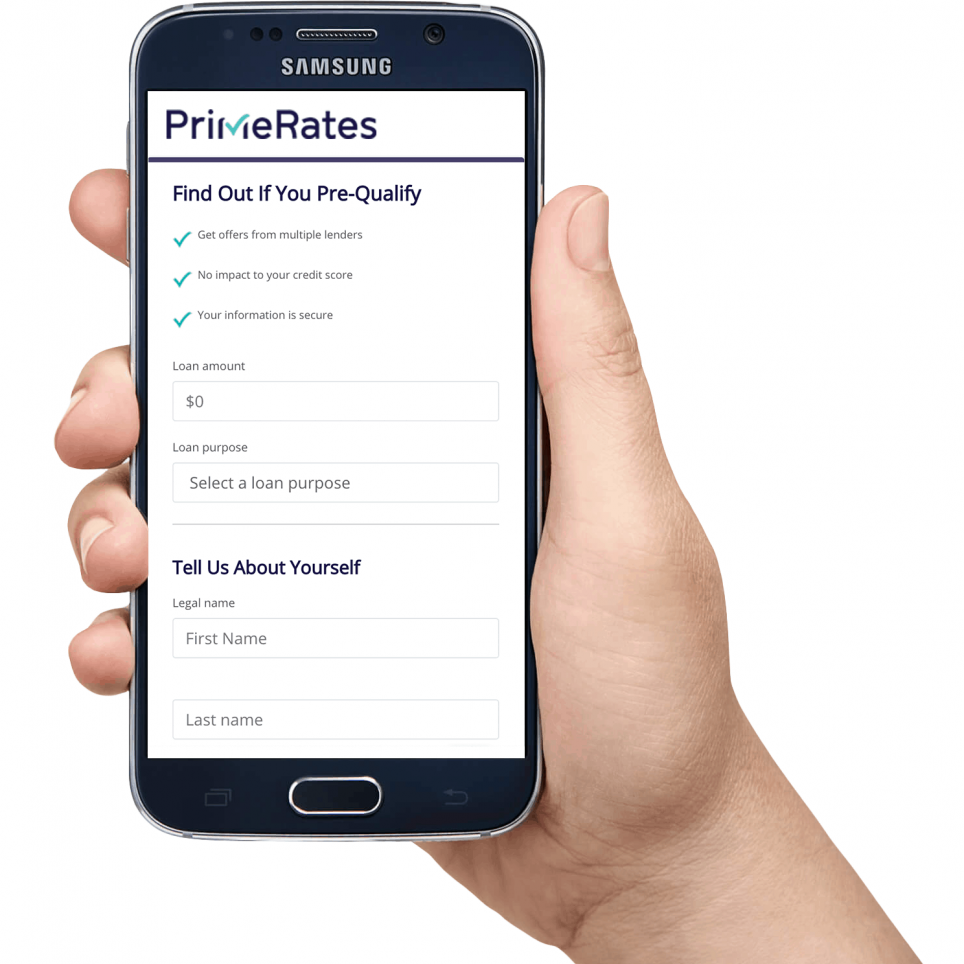Get your rate in minutes
No credit score impact
Borrow up to $100,000
PrimeRates Lender Partner Network

LightStream

Prosper

Upgrade

BestEgg

SoFi

Payoff

LendingPoint

FreedomPlus

OneMain

Avant
How PrimeRates Works
PrimeRates provides access to personalized loan offers through our simple and quick pre-qualification application. Once you're pre-qualified, you can select the best offer for you and finalize the loan application with the lender.
Apply in minutes
Simple pre-qual application in less than 1 minute.
Select your loan offer
Choose the offer that best fits your needs.
Receive funds quickly
Finalize your loan offer, get approved, and receive funds.

Financing a Home Addition
Why is a personal loan the best option for home addition financing?
Home additions are a great way to boost the value of your home. Regardless of your house’s square footage, adding valuable features that increase its functionality not only gives you the freedom to build the house that you’ve always wanted but also makes your home more appealing to future buyers. At the end of the day, wouldn’t it be incredible to have everything you need in the comfort of your own home?
But before you start going on Pinterest to find inspiration, let’s take a step back and talk about what exactly home additions are.
What exactly is a home addition? What’s it for?
Simply put, carefully planned home additions can change the way you live. We specifically said “carefully planned” because, as you may already know, home additions can be expensive investments. Not planning your home addition project carefully can leave you with a ton of debt and, at times, an unfinished house. As a homeowner, it’s your responsibility to determine home additions that would make the most sense both financially and functionally. Since financing a home addition isn’t exactly the cheapest project to fund, it’s important to only add features that would directly address your current needs.
Home Addition: Where to start?
Home addition projects can be overwhelming especially if you don’t know where to start. Let’s take a look at some of the first steps to consider before adding a new feature to your home:
Check local rules and regulations
Before forking out thousands of dollars for your home addition project, it’s best to check local zoning ordinances and other regulations first. Zoning regulations are able to dictate the size and height of your house to protect the value of your property and other properties in your area. Prior to planning, check your area’s zoning rules and regulations to ensure that your home addition project isn’t breaking any laws.
Determine your budget
Again, financing a home addition can be costly. As the one paying for this project, you should be able to set a budget that you are comfortable with. Keep in mind that the budget you want to spend may not be the exact cost of your home addition as the cost of materials and labor may vary from one construction company to another.
According to Home Advisor, the average cost to build an addition or add a room to your home is $45,808. Home addition costs differ from one project to another. While Home Advisor’s average costs may not apply to your particular project, it should give you an idea about the amount of money you should be prepared to spend.
Identify an addition that complements your home
It’s always best to take a look at your home’s current floor plan to identify an addition that fits your home. Do you have space to add another room? Can your home’s current structure support building a second floor? Is your home addition project going to complement the overall look and feel of your home? What type of home addition would serve your family best? These are just some of the questions to ask yourself before undertaking a home addition project. It’s also best to consult an architect or a contractor while planning an addition to your home to ensure that it is practical and economical.
What is the typical cost of a home addition project?
As mentioned above, homeowners should be prepared to spend $45,808 on a home addition project. Some costs to take into account are site preparation, architectural services, labor costs, wiring, ceiling and walls, and roofing (if applicable). Your costs would also depend on the type of home addition you want. For instance, adding a second story would most probably be more expensive than adding another room.
How to finance a home addition
Although expensive, home addition projects may greatly increase the value of your home. But unless you have a good amount of savings set aside, you will most likely need to take out a loan to finance your home project.
Financing options for home addition
Let’s take a look at some of the best financing options for your dream home addition project.
What is a Home Equity Loan?
A home equity loan is a fixed amount of money that is secured by your home. Secured loans usually mean that there is collateral backing involved. If you become unable to repay your loan, then your lender has the right to take ownership of your property.
Pros of a Home Equity Loan for Home Addition:
- Fixed interest rates
- Lower borrowing costs
- Tax-deductible interest payments
Cons of a Home Equity Loan for Home Addition:
- Closing costs and other fees
- You may lose your home if you default on your loan
- You need to pay off your balance if you’re planning to sell your home
What is a Home Equity Line of Credit?
Home Equity Lines of Credit (HELOCs) is a revolving credit line that you can use to fund your home addition project. While home equity loans and HELOCs use your home as collateral, the biggest difference between the two is that home equity loans come with fixed interest rates while HELOCs have variable interest rates.
Pros of a Home Equity Line of Credit for Home Addition:
- Low interest rates depending on your creditworthiness
- Interest may be tax-deductible
- Borrow only what you need
Cons of a Home Equity Line of Credit for Home Addition:
- You’re using your home as collateral
- Variable interest rates could make payments unpredictable
- Beware of hidden fees
Credit Cards for Home Addition
Credit cards are another option to fund your home addition projects. But it depends on the extent of your renovations and your current financial standing. If you’re planning a small remodeling project, then a credit card may work well for you depending on your income and your overall ability to pay.
Pros of Credit Cards for Home Addition:
- Ideal for cash back, earning rewards, and discounts
- No collateral involved
- Some promotions could involve 0 interest rates (as long as you pay in full within the allowed time frame)
Cons of Credit Cards for Home Addition:
- Short pay-off period
- No tax deductions for interest paid
- Late fees
Cash-Out Refinance for Home Addition
When you have built enough equity in your home, the more money you can borrow to fund your home addition project. The way cash-out refinancing works is that to be eligible, the value of your home must be greater than what you owe on your mortgage.
Pros of cash-out refinance for home addition:
- Lower interest rates compared to other financing options
- Consolidate your debt in one single loan
- Could be Tax-deductible
Cons of cash-out refinance for home addition:
- Payments could go up
- Risk of foreclosure
- Closing costs
Personal Loans for Home Addition
A personal loan can be used to make a big purchase, consolidate debt, cover emergency expenses, or fund your home addition project. Personal loans are usually unsecured which means your lender wouldn’t require collateral.
Pros of personal loans for home addition:
- Quick loan application and approval
- No collateral needed
- Variety of lenders to choose from
Cons of personal loans for home addition:
- Rates may be higher compared to other financing options
- May come with additional fees and penalties
- Potential for scams
No two home addition projects are alike - so the best loan for you may not meet the needs of other people’s home addition projects. As the borrower, it’s up to you to decide which type of loan best suits your home addition requirements as well as your current financial situation.
Home addition loan requirements
Banks, credit unions, online lenders, and other financial institutions may ask you to submit various types of requirements to help them better understand your current financial standing and determine whether or not you’re responsible enough to be granted a loan. While it’s true that every lender is different, most still base a borrower’s eligibility on the following standard factors:
- Credit score - Your credit score determines how creditworthy you are. A low credit score indicates that you might be a risky borrower.
- Proof of income and employment - Most lenders may want to ask you to submit proof of income and employment to verify your ability to repay your loan.
- Collateral - Having collateral increases your chances of getting approved for a loan. Remember, lenders also want to protect themselves from losing money. If a borrower is willing to use personal property as collateral, this gives lenders a fair tradeoff in case you fail to make your loan payments.
This list is by no means a comprehensive list of home addition loan requirements. Make sure that you equip yourself with enough information about your prospective lender’s requirements before applying for a loan.
Why is a personal loan the best option for home addition financing?
When it comes to home addition loans, a personal loan is your best option if you’re not willing to risk losing your home. Usually, personal loans for home addition financing come with decent interest rates that people with great financial standing might be comfortable with. In addition to having no collateral involved, borrowers can also choose from a variety of lenders that offer them.
Are there any other options for home addition financing?
If you want a quick and easy loan application process, try PrimeRates. PrimeRates provides borrowers access to personalized offers through a seamless pre-qualification application. Once you’re pre-qualified, you now have the option to select the best offer for you and finalize your loan application with your chosen lender. Sounds simple enough? Let’s look at the step-by-step process:
- Pre-qualification application takes less than 2 minutes to complete and would not have an impact on your credit score
- After getting pre-qualified, choose the offer the best fits your needs by comparing monthly payments, APRs, and loan amounts
- Finalize your loan offer with your chosen lender - your lender may ask for additional documents such as ID, income, and other relevant financial documents
- Once approved, all you have to do is wait for your funds!
This simple and easy to use tool can be used for a variety of loan purposes from personal loans for a home addition to business loans for small businesses.